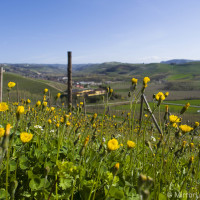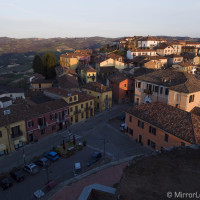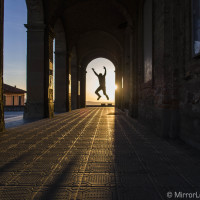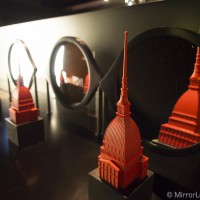We inaugurate the comparison section of our site with two of the most interesting mirrorless cameras available to date: the Olympus OM-D E-M5, the flagship of the Olympus Micro Four Thirds line, and the new Fujifilm X100s.
But what is the purpose of comparing two cameras?
Well, for us, it is a way of pointing out not only the strengths and weaknesses of each model, but it is also an occasion to summarize our personal experiences with them. It is a place where we can give you advice about the style of photography that best suits these cameras, while helping you answer that tricky question: which model is best for me?
You won’t find scientific comparisons but rather our personal experience with each camera based on a real-world usage. For more information about the cameras, you can check out our reviews and galleries across the site (relevant links are mentioned throughout the article).
But that is not all: it isn’t just about us. If you’ve had the chance to use both of these cameras and want to share your opinion about them, feel free to leave a comment or even write to us at mirrorlessons@gmail.com. We would love to hear your two cents!
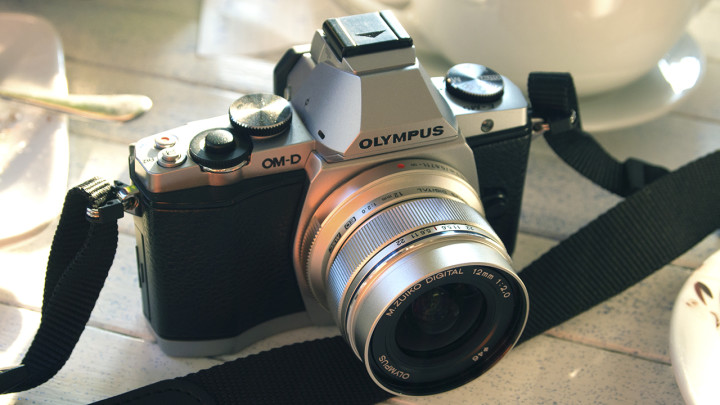
Olympus OM-D E-M5
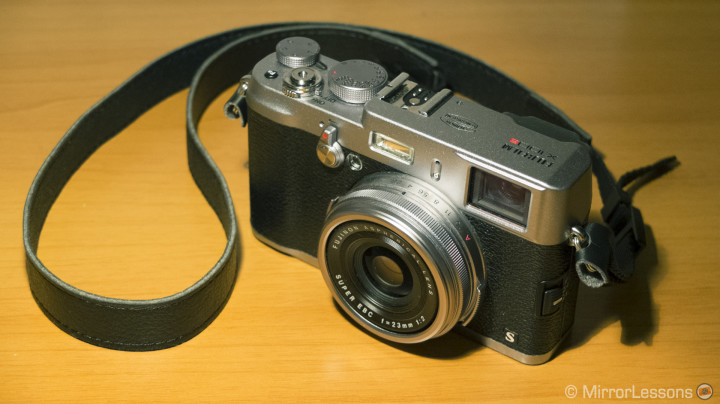
Fujifilm X100s
Main Specs
The biggest difference between these two cameras is that:
The E-M5 is an interchangeable lens system camera and features a Micro Four Thirds sensor, which is two times smaller than a Full Frame sensor (35mm equivalent).
The X100s has a fixed 23mm lens (35mm equivalent) and features an APS-C sized sensor with Fuji X-Trans sensor technology. The sensor is bigger than M43 and is 1.5 times smaller than Full Frame.
What is the meaning of this?
First, since the E-M5 is an interchangeable lens camera, the quality of your pictures will be affected by the lens you are using. This, of course, gives the EM-5 a lot more versatility, allowing you to take a variety of different shots.
With the X100s and its fixed prime lens, you are limited to a 23mm (35mm equivalent). This isn’t necessarily a bad thing, but it reinforces the fact that this is a niche camera, designed for specific purposes and not to be used in every situation (unless you are a photographer looking to push the boundaries of your creativity!).
Furthermore, they possess two different types of sensor technology. The X100s has a better dynamic range and depth of field. However, in my opinion this isn’t a big issue, especially concerning the depth of field. I will explain this later on.
[stextbox id=”text-box-toc” caption=”Main Specs” collapsing=”true” collapsed=”false”]
The OM-D E-M5
- Sensor: 16.1 megapixels 4/3 Live MOS Sensor
- Lens system: Micro Four Thirds interchangeable lens system
- ISO Sensitivity: 200 – 25600 ISO
- Continuous shooting: 9 fps with single AF mode
- Autofocus: Autofocus with image contrast detection system and 35 focusing points
- Internal Stabilization: Yes (5 axis image stabilisation)
- Viewfinder Eye-level electronic viewfinder, approx. 1.44M
- LCD Screen 3.0-inch tilting OLED monitor, approx. 610k dots, Touch control
- Movie recording:: Full HD: MOV (MPEG-4AVC/H.264 ) and AVI (Motion JPEG), interlaced, up to 20 mbps
- Picture Profile
- Water and dust proof Yes
- Sensor Cleaner Yes (Supersonic Wave Filter (dust reduction system for image sensor)
- Built-in Flash No (but an external flash is provided with the camera)
- Dimensions: 4.8 inch (W) x 3.5 inch (H) x 1.7 inch (D)
- Weight: Approx. 15 ounces
The Fuji X100s Main Specs
- Sensor: 16.3 million pixels – 23.6mm x 15.8mm (APS-C) X-Trans CMOS II
- Lens System: fixed 23mm f/2, equivalent to 35mm on a 35mm format
- ISO Sensitivity: 200 – 6400, extendable to 100, 12800 and 25600 (JPG only)
- Continuous shooting: approx. 6 fps (max. 31 frames)
- Autofocus: intelligent Hybrid AF (TTL contrast AF / TTL phase detection AF)
- Internal Stabilization: No
- Viewfinder Hybrid (optical and electronic)
- LCD Screen 3.0-inch OLED monitor, approx. 610k dots
- Movie recording: 1920 x 1080 pixels (60fps/30fps) with stereo sound
- Picture Profiles Film Simulation modes
- Water and dust proof No
- Sensor Cleaner No
- Built-in Flash Yes
- Extras: Motion Panorama, Multiple Exposure modes
- Dimensions: 126.5 (W) x 74.4 (H) x 53.9 (D) mm / 5.0. (W) x 2.9 (H) x 2.1 (D) in.
- Weight: Approx. 445 g / 15.7 oz. (including battery and memory card)
[/stextbox]
Ergonomics and Design
Both cameras have inherited a retro design from old film cameras, a style which is very common and popular these days.
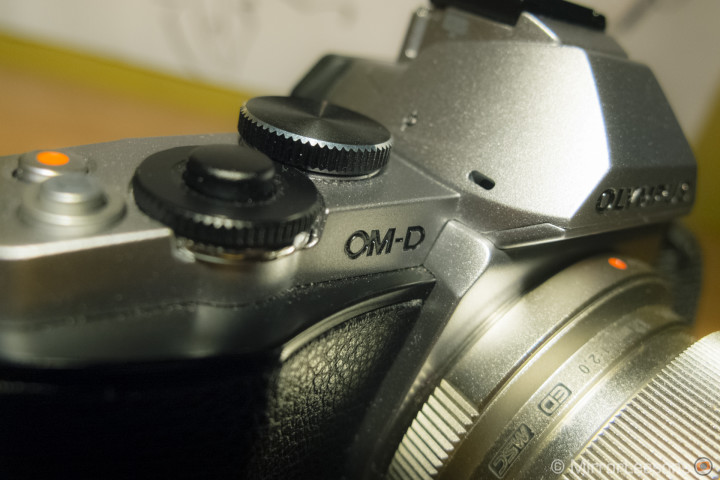
The OM-D design matches that of the old OM SLR Olympus cameras. It is actually identical, but the E-M5 is slightly smaller than its grandfather.
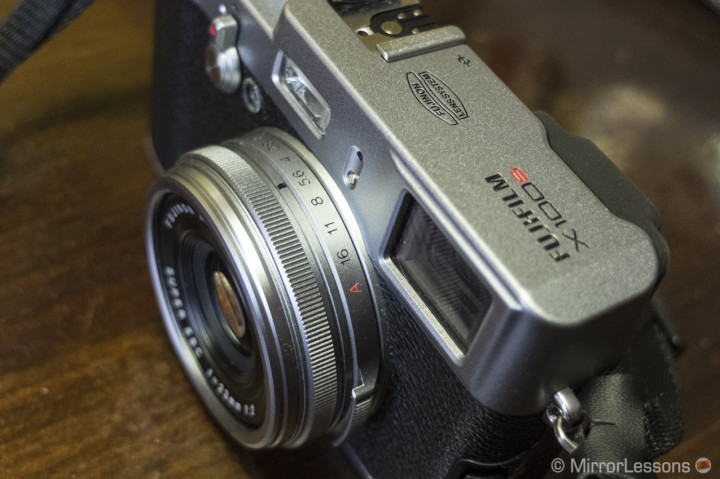
The X100s, on the other hand, takes its design from rangefinder cameras. The similarity with Leica cameras in particular is quite obvious.
Both have a wonderful design and a very sturdy build, with a solid metal feel. But when it comes to ergonomics…
…the OM-D body is slightly smaller and lighter (depending on which lens you mount on it, of course), and has two very nice dials for aperture and shutter speed but the various buttons at the top and rear are a little bit too small and quirky. Some of them feel overly delicate (especially the Live view button).
…the X100s is slightly bigger; therefore it feels nicer to hold. The various buttons are very well-placed, and the shutter speed dial and aperture ring on the lens are definitely a welcome addition.
Functionality & Ease-of-use
Both cameras are easy to use but their menu systems and options are quite different.
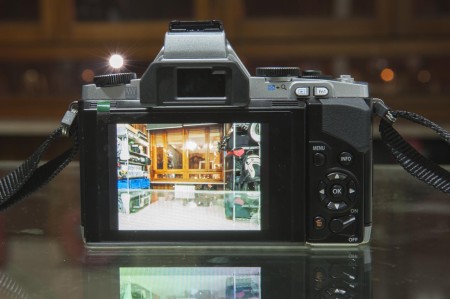
The E-M5 has a more complex and complete menu system. The main settings of the camera can be accessed with the OK button. It has two function buttons and the arrow pad can also be customized. Since these buttons are neither very precise or sturdy, more than once I found myself hitting them too fast and accidentally skipping the setting I wanted.
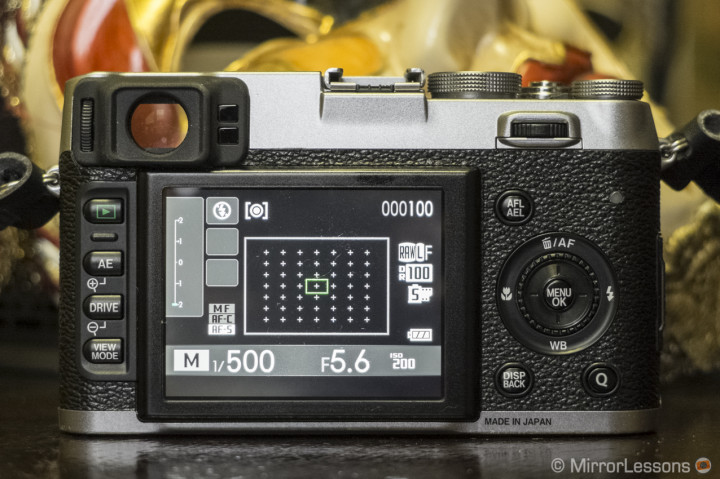
The advantage of the X100s is without a doubt its “Q” button where you can access in an instant all the main settings for your pictures. Furthermore, the “DRIVE” button and the AE button let you quickly access other important settings (shooting mode and exposure) on the camera. The Menu system is very simple and easy to learn. The only thing missing is an extra Fn button (it only has one).
Both cameras feature a high quality OLED screen and viewfinder, but the way you use them differs.
The E-M5 has the advantage of a tilting LCD screen, which is very useful for high-angle shots. It is a touch screen and while I prefer relying on buttons for the different operations and settings, I find it really helpful to quickly change the AF focus point without using any buttons or dials of any kind.
Its viewfinder, despite being electronic, is also very detailed and bright. I rarely miss the optical viewfinder on my DSLR.
The X100s has a hybrid viewfinder, which is one of the most interesting features of Fuji’s camera system. You can quickly switch between an optical and electronic viewfinder. The OVF is brighter and sharper than the EVF and covers a larger area than my actual frame. However, using the OVF you have to be aware of the parallax issue: what you are seeing is not exactly what you are shooting, because the viewfinder is at a slight distance from the lens. The EVF, on the other hand, is more precise for focusing on short distances and also offers interesting tools for manual focusing such as peak highlight and digital split imaging.
The LCD screen is also very nice despite the fact it can’t be tilted.
Image Quality
Both cameras deliver exceptional image quality, shooting in both RAW and JPG.
Despite its small sensor, the E-M5 defends itself very well when it comes to image quality and dynamic range. For me, its strongest point is ISO performance. Even some pictures taken at 25600 ISO look good! The JPGs are also stunning.
In the case of the X100s, having a larger sensor allows for better dynamic range. The X-Trans sensor is exceptional for colours, tonal range and high ISO performance. It looks less digital and has more organic noise at high ISO that I personally find more pleasant.
The RAW files are also amazing, among the best I have ever worked with. The only limit is that the extended ISO (12800 and 25600) will only work for JPGs.
Colour reproduction is also very good from both cameras…
It is without a doubt a strong point for the EM-5. Colours are warm, powerful and highly detailed. I don’t worry too much about the result when shooting with the vivid colour profile or in JPG as I might with other cameras, as I know the quality will be good. (This said, I still prefer working with RAW files.)
The colours of the X100s are different – I would say less “digital” than other cameras, and it is in this realm that the x100s really stands out from the crowd. The X-Trans sensor has that ‘something extra’ when it come to tonal range. The colour reproduction produced by the Film Simulation Modes (the default picture profile in other cameras) is also wonderful – I have a particular fondness for the Astia mode.
Below is an informal gallery featuring pictures taken with both cameras in various locations and situations.
Of course, one of the main differences is the lens system.
The E-M5 is an interchangeable lens system camera: the quality of your pictures can vary a lot depending on the lens you are using. Primes are better, like the wonderful M.Zuiko 12mm f/2, or the M. Zuiko 45mm f/1.8. Some criticize M43 cameras for having poor bokeh capabilities, but if you mount a good lens on it, you won’t be disappointed.
The fixed Fujinon 23mm f/2 (35mm equivalent) limits the usability of this camera, as it has been designed primarily for street photography. The lens is fairly sharp at its fastest aperture, and become razor-edged from f/4, revealing the great sharpness capabilities of the X100s. At times, it has a little bit of distortion. It is overall a nice lens but it isn’t the greatest feature of the camera and it certainly won’t be the reason you buy the x100s. But the fact that the X100s has a fixed lens puts you in a different mindset when you shoot. It makes you carefully plan out the shot you are going to take, before you take it. I personally find it very interesting but not everyone agrees.
200M.Zuiko 45mm f/1.8
Voigtländer 25mm f/0.95
No processed version
You can also visit the additional E-M5 gallery:
You can also visit the additional X100s gallery:
Autofocus and Performance
Both cameras feature interesting focus options, but the performance is very different…
The OM-D E-M5 clearly has an advantage here when it comes to autofocus: it is faster, more reliable and more precise. The ability to quickly change the focus point with the touch screen is a great advantage. The camera also works well for focus tracking in AF-C mode, even though focus tracking isn’t its strongest point.
Autofocus was a big complaint on the X100, and while it has been improved a lot with the new X100s, it is still not 100% reliable. The focus lock is slower than what Fuji claims in certain situations, especially in low-light conditions where it has difficulty locking onto subjects. Using the EVF slightly increases the AF performance. I also found myself in a couple of situations where the display gave me a positive AF confirmation but the resulting picture was out of focus.
The overall performance of the two cameras is very good. The both turn on very quickly, and all operations run smoothly with any glitches. They are also very fast in burst mode.
The E-M5 has the advantage of being able to shoot at 9fps in AF-S mode. Also, another difference is that the E-M5 features 5 axis stabilization that is really impressive and will work with any M43 lens. It is useful especially when using telephoto or zoom lenses.
The X100s has a burst of 6fps maximum, which isn’t bad at all. The burst works automatically when you set up the bracketing function and take three shots in a row in a RAW. Very nice to use.
The camera doesn’t have internal or optical stabilization but you don’t really need it: considering its small and light body, and its tiny “pancake style” lens and focal length, you can easily shoot at a slow shutter speed without issues.
Extra Features and Video Capabilities
Both camera have interesting extra functionalities.
The E-M5 features a Panorama mode that is almost useless in my opinion. The reason is simple: you have to merge the single photographs with the Olympus Software (Viewer 2) which is too slow to be practical. It is better to do it with Photoshop.
The X100s features a nice Panorama mode. It is very easy to use and produces good results. I personally prefer doing panorama manually and merging the photos with Photoshop later, but this is a personal choice.
The X100s also has a double exposure mode that can be very fun to use if it is the kind of thing you like to experiment with.
When it comes to video capabilities, neither are suited for professional purposes, but…
The EM-5 offers more manual control (aperture, shutter speed, ISO) and can focus while recording. The video codec isn’t bad even though it is excessively compressed and has a limited bitrate.
The X100s video mode is automatic: you cannot choose aperture, ISO or shutter speed. It lacks 25p PAL recording and cannot focus during recording.
Battery life
Battery life is very different:
The EM-5 clearly has an advantage here: I am always able to shoot for a full day with just one battery.
With the X100s, more than once I found myself with a dead battery around mid-afternoon, even though I’d fully recharged it the night before. I ended up buying a second battery to be safe.
Conclusion
So, if you went through the entirety of my comparison, you can probably already guess what my conclusion is: we simply can’t say that one camera is better than the other, because they are two different models that have been designed for two completely different purposes. The important point is that both produce excellent image quality. You really have to make hypercritical comparisons to highlight the differences between the two, even though their technical specifications may suggest otherwise.
The E-M5 is certainly more versatile: the Micro Four Thirds system offers a great variety of lenses from Olympus, Panasonic and third party manufacturers, and it has all the accessories you need to use it as a real alternative to DSLRs, with the advantage of it being lighter and smaller.
The X100s is very good at what it has been designed to do: street photography. It is small, light and discreet. Despite its few weakness, I really enjoy using it and I am starting to employ it as a second body not only for personal purposes but also professional. At the same time, I know it won’t ever become my main camera, as I would always miss the beauty of a good wide angle lens, for example.
The bottom line is:
Choose the EM-5 if:
- you like to shoot with more than one lens, or if you like telephoto and wide angle shots
- autofocus speed is a priority
- you are looking for a versatile system that can be an alternative to a DSLR
Choose the X100s if:
- street photography is your favourite kind of photography
- overall image quality and excellent RAW files are a priority
- you are looking for a second body to add to your current system
Reviews
You can also read our reviews about the two cameras:

















